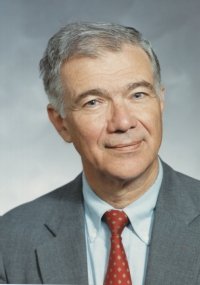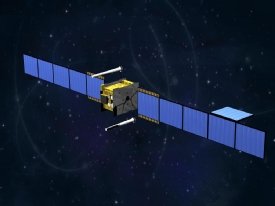From atoms to satellites
Alumnus Alfred U. Mac Rae receives Distinguished Alumni Award

While those who attended Syracuse University during the late 1950s may not have known his name, many recall the Ghost of Archbold Stadium a.k.a. Alfred U. Mac Rae ’54, G’57, Ph.D. ’60. Mac Rae haunted the legendary stadium with the melodious sounds of bagpipes during the late evening hours after spending long days toiling in a physics research laboratory. An intrepid student reporter from the Daily Orange investigated the source of the music and coined the phrase in an article.
Mac Rae went on to become a pioneer in the research and development of integrated circuits and later in satellite technology at AT&T Bell Telephone Laboratories. Mac Rae and his wife, Peggy, are residents of Berkeley Heights, New Jersey. He was recently awarded the 2012 Distinguished Alumni Award from SU’s College of Arts and Sciences.
“My ancestors are from the Highlands of Scotland,” says Mac Rae, who was a Pipe Major in a Syracuse bagpipe band that competed in the United States and Canada. Until recently, he taught others to play. “Pipers would come to our house. It was part of my life. It’s in the blood.”
While his love of the bagpipes is in the blood, Mac Rae’s skills in the laboratory led to a distinguished career during which he published more than 50 papers, was a sought after guest speaker by professional societies and universities, was awarded 18 patents on ion implantation and integrated circuit fabrication techniques, and was recognized for his work by three distinguished awards from the IEEE (the Institute of Electrical and Electronic Engineers), the world’s largest professional organization for the advancement of technology. In 2003, Mac Rae was elected to the prestigious National Academy of Engineering.
Integrated circuits are as ubiquitous as stars. They are part of every piece of electronics manufactured the world over—from computers and cellphones to automatic car windows and smart toasters and coffee makers. But when Mac Rae finished his Ph.D. in physics in SU’s College of Arts and Sciences, integrated circuits had just been invented. “In the manufacture of integrated circuits, it’s necessary to place impurities into the silicon, the basic material of the integrated circuit, to selectively change the electrical characteristics,” Mac Rae says. “But during the early 1960s, the only way to do that was by chemical means, which had its shortcomings.”
Mac Rae began his career in 1960 in the research area of Bell Telephone Laboratories investigating the location of atoms on the surfaces of metals and semiconductors. He then formed a team to develop a new technique to introduce ions (electrically charged atoms) into silicon to modify its properties and create the electrically active regions that are important for making integrated circuits work. The process he developed is key for the inexpensive mass production of modern silicon integrated circuits. The rest is history. In 1969, Mac Rae was appointed head of the Exploratory Semiconductor Technology Department for Bell Labs and later served as director of Integrated Circuit Development.
“Last year more transistors were manufactured than grains of rice were harvested,” Mac Rae says. “It’s big business. I helped develop the technique that allowed these things to be manufactured. I’m very proud of that.”
Mac Rae went on to become a pioneer in the research and development of integrated circuits and later in satellite technology at AT&T Bell Telephone Laboratories. Mac Rae and his wife, Peggy, are residents of Berkeley Heights, New Jersey. He was recently awarded the 2012 Distinguished Alumni Award from SU’s College of Arts and Sciences.
“My ancestors are from the Highlands of Scotland,” says Mac Rae, who was a Pipe Major in a Syracuse bagpipe band that competed in the United States and Canada. Until recently, he taught others to play. “Pipers would come to our house. It was part of my life. It’s in the blood.”
While his love of the bagpipes is in the blood, Mac Rae’s skills in the laboratory led to a distinguished career during which he published more than 50 papers, was a sought after guest speaker by professional societies and universities, was awarded 18 patents on ion implantation and integrated circuit fabrication techniques, and was recognized for his work by three distinguished awards from the IEEE (the Institute of Electrical and Electronic Engineers), the world’s largest professional organization for the advancement of technology. In 2003, Mac Rae was elected to the prestigious National Academy of Engineering.
Integrated circuits are as ubiquitous as stars. They are part of every piece of electronics manufactured the world over—from computers and cellphones to automatic car windows and smart toasters and coffee makers. But when Mac Rae finished his Ph.D. in physics in SU’s College of Arts and Sciences, integrated circuits had just been invented. “In the manufacture of integrated circuits, it’s necessary to place impurities into the silicon, the basic material of the integrated circuit, to selectively change the electrical characteristics,” Mac Rae says. “But during the early 1960s, the only way to do that was by chemical means, which had its shortcomings.”
Mac Rae began his career in 1960 in the research area of Bell Telephone Laboratories investigating the location of atoms on the surfaces of metals and semiconductors. He then formed a team to develop a new technique to introduce ions (electrically charged atoms) into silicon to modify its properties and create the electrically active regions that are important for making integrated circuits work. The process he developed is key for the inexpensive mass production of modern silicon integrated circuits. The rest is history. In 1969, Mac Rae was appointed head of the Exploratory Semiconductor Technology Department for Bell Labs and later served as director of Integrated Circuit Development.
“Last year more transistors were manufactured than grains of rice were harvested,” Mac Rae says. “It’s big business. I helped develop the technique that allowed these things to be manufactured. I’m very proud of that.”

Looking for a new challenge, Mac Rae was reassigned in 1983 to the Bell Labs Satellite Communications and Signal Processing Laboratory. “We designed new satellites, monitored their manufacturing, oversaw the design of the rockets that launched the satellites, tested the satellites, monitored the satellites orbiting the Earth at facilities across the country, and developed communications services that are satellite based,” Mac Rae says. “It was an exciting time to be involved in something as glamorous as space.”
Mac Rae retired as director of Skynet Satellite Communications Laboratory in 1995. He remained active in the industry by launching a consulting company to advise on telecommunications satellite technology and systems. In 1998, he was a member of a distinguished advisory panel on global satellite communications technology convened by the International Technology Research Institute and funded by NASA and the National Science Foundation. He still does some consulting work through his company, Mac Rae Technologies.
I’ve really had three careers,” Mac Rae says. “One in basic research, one in integrated circuit research and development, and a third in satellites. I feel very fortunate. I never had a dull day; I was always learning something new and worked with many talented colleagues.”
Mac Rae retired as director of Skynet Satellite Communications Laboratory in 1995. He remained active in the industry by launching a consulting company to advise on telecommunications satellite technology and systems. In 1998, he was a member of a distinguished advisory panel on global satellite communications technology convened by the International Technology Research Institute and funded by NASA and the National Science Foundation. He still does some consulting work through his company, Mac Rae Technologies.
I’ve really had three careers,” Mac Rae says. “One in basic research, one in integrated circuit research and development, and a third in satellites. I feel very fortunate. I never had a dull day; I was always learning something new and worked with many talented colleagues.”
Media Contact
Judy Holmes
